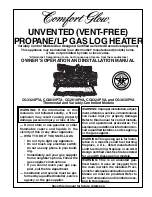
4
For either confined or unconfined space in a building of
tight construction with inadequate infiltration, air must be
drawn from the outdoors or from spaces that freely
communicate the outdoors. Two permanent openings located
as indicated above are to be provided as follows:
1.
When communicating with outdoor directly, or by means
of vertical ducts, each opening shall have a free area
of not less than one square inch per 4000 BTU/Hr of
total input of all appliances in the space.
2.
When communicating with outdoors by means of
horizontal ducts, each opening shall have a free area of
not less than one square inch per 2000 BTU/Hr of
total input of all appliances in the space.
For detailed reqirements see
-
in Canada, CAN 1-B 149 Installation Codes
-
in U.S., ANSI Z223.1/NFPA 54 National Fuel Gas Code.
WARNING
1.
Flammable materials, gasoline, pressurized containers,
or any other items or articles that are potentially fire
hazards must never be placed on or adjacant to the
heater. The appliance area must be kept free of all
combustible materials, gasoline and other flammable
vapors and liquids.
2.
Do not obstruct the flow of combuston and ventilation
air to the appliance.
CLEARENCE
In Canada
The W 325 and the W 400 are design certified for installation
on a combustible wall (for the W 325 the wall bracket
supplied with the unit must be used for mounting to
combustible construction), and for installation in an alcove
or closet with minimum clearances to 0 mm from back, 102
mm (4 inches) from sides, 305 mm (12 inches) from top and
bottom, and 102 mm (4 inches) from front. A minimum of
305 mm (12 inches) shall be allowed for maintenance of
serviceable parts.
Clearence from vent is dependant upon the clearence rating
of the venting material used; that is, type B-1 vent is approved
for 1 inch clearence, B-2 vent for 2 inch, etc.
In United States
The W 325 and the W 400 are design certified for installation
on a combustible wall (for the W 325 the wall bracket
supplied with the unit must be used for mounting to
combustible construction), and for installation in an alcove
with minimum clearences to combustible construction of 0
mm from back, 102 mm (4 inches) from sides, 305 mm (12
inches) from top and bottom. In addition, the WR 325 has
also been design certified for closet installation with minimum
clearences to combustible construction of 0 mm from back,
102 mm (4 inches ) from sides, 305 mm (12 inches) from
top and bottom, and 102 (4 inches) from front. A minimum
of 305 mm (12 inches) shall be allowed for maintenance of
serviceable parts.Clearence from vent is dependent upon
the clearence rating of the venting material used, that is,
type B-1 vent is approved for 1 inch clearence, B-2 vent for
2 inch, etc.
MOUTING
The W 325 K.. and W 400 K.. are design certified for
mounting to a wall. A wall bracket, see figure 1 is provided
with the W 325 K.. and must be used when the heater
mounted on a combustible wall. Heaters may not be installed
directly on a carpeted wall.
The heater, or the wall bracket, must be mounted to the wall
using appropriate anchoring materials.
WARNING
Failure to use the wall bracket with the W 325 K… when
installing the unit on combustible construction will cause
an unsafe condition and possible fire. In addition, failure to
use the wall bracket when installing the W 325 K… on
combustible construction will be in violation of A.G.A. and
C.G.A. certification of the unit.
Note:
If wall is a stud wall sheethed with plasterboard it is
recommended that support board(s), either 1 x 4’s or ½
(minimum) plywood first be attached across a pair of
studs and then heater, in the case of the W 400 K…,
or the wall bracket, in the case of the W 325 K…, be
attached to the support boards. See figure 2.
Expansion and contraction of piping due to changing water
temperature in pipes imparts movement to heater which, if
mounted directly to a brittle, friable board such as
plasterboard can cause failure of mounting.
Figure 2
WALL STUDS
WALL
BRACKET
1” X 4” SUPPORT
BOARDS





































